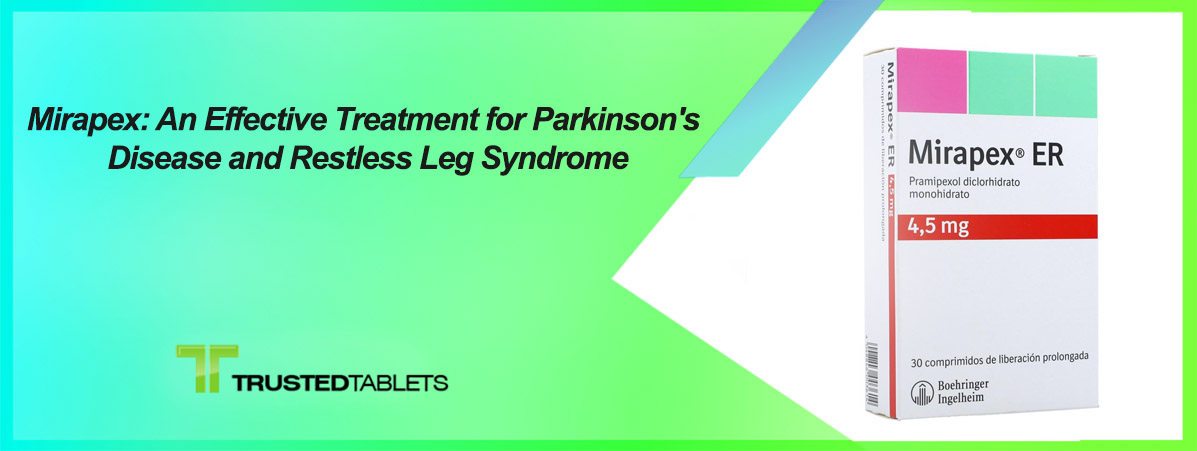Mirapex, also known as Pramipexole, is a medication used as a dopamine agonist. It is primarily prescribed for managing symptoms of Parkinson’s disease and restless leg syndrome. Let’s delve into some common questions and outlines regarding Mirapex:
1. What are the indications for using Mirapex?
Mirapex is indicated for:
- Idiopathic Parkinson’s disease
- Moderate to severe restless leg syndrome
2. What are the advantages of using Mirapex?
The advantages of Mirapex include:
- Controlling Parkinson’s symptoms such as tremors, muscle rigidity, and bradykinesia
- Alleviating uncomfortable sensations and urges to move legs in restless leg syndrome
- Convenient once-daily dosing regimen
Mirapex: A Boon for Parkinson’s Patients
Parkinson’s disease is a neurodegenerative disorder that affects movement. Its symptoms, such as tremors, stiffness, and slow movement, can significantly impair daily life. Mirapex, with its dopamine agonist properties, offers considerable relief to patients by targeting these symptoms directly.
Mechanism of Action
Mirapex works by stimulating dopamine receptors in the brain. Dopamine is a neurotransmitter involved in controlling movement and emotions. In Parkinson’s disease, there is a deficiency of dopamine, leading to movement difficulties. Mirapex helps to compensate for this deficiency by mimicking the action of dopamine in the brain.
Efficacy in Controlling Symptoms
Numerous clinical studies have demonstrated the efficacy of Mirapex in managing Parkinson’s symptoms. It effectively reduces tremors, muscle rigidity, and bradykinesia (slowness of movement), allowing patients to regain control over their movements and improve their quality of life.
Improved Quality of Life
Apart from its efficacy in symptom management, Mirapex also contributes to an improved quality of life for Parkinson’s patients. By alleviating motor symptoms, it enables patients to engage in daily activities more comfortably and independently.
Treatment of Restless Leg Syndrome
In addition to Parkinson’s disease, Mirapex is also indicated for restless leg syndrome (RLS). RLS is characterized by uncomfortable sensations and an irresistible urge to move the legs, particularly at night. Mirapex helps relieve these symptoms, allowing for better sleep and improved overall well-being.
Convenient Dosage Regimen
One of the significant advantages of Mirapex is its convenient once-daily dosing. This simplifies medication management for patients, enhancing adherence to treatment regimens and ensuring consistent symptom control throughout the day.
Important Considerations
While Mirapex offers significant benefits, it’s crucial to use it under medical supervision. The medication should only be taken as prescribed by a healthcare professional, as improper use can lead to adverse effects. Additionally, patients should be aware of potential drug interactions and follow-up with their healthcare provider regularly for monitoring.
FAQ
1. Is Mirapex suitable for all Parkinson’s patients?
- Mirapex may not be suitable for every Parkinson’s patient. It’s essential to consult a healthcare provider to determine if it’s the right treatment option based on individual medical history and symptoms.
2. Can Mirapex be taken without a prescription?
- No, Mirapex is a prescription medication and should only be taken under the guidance of a healthcare professional.
3. What are the common side effects of Mirapex?
- Common side effects of Mirapex may include nausea, dizziness, drowsiness, and constipation. However, not everyone experiences these side effects, and they may diminish over time.
4. How long does it take for Mirapex to start working?
- The onset of Mirapex’s effects can vary from person to person. Some individuals may experience symptom improvement within days, while others may take several weeks to notice a difference.
5. Can Mirapex be used long-term?
- Mirapex can be used as a long-term treatment for Parkinson’s disease and restless leg syndrome. However, the dosage may need to be adjusted periodically based on the patient’s response and any changes in symptoms.
6. Are there any lifestyle changes recommended when taking Mirapex?
- It’s essential to maintain a healthy lifestyle when taking Mirapex, including regular exercise, a balanced diet, and adequate sleep. Avoiding alcohol and certain medications that may interact with Mirapex is also advisable.
7. Can Mirapex interact with other medications?
- Yes, Mirapex can interact with certain medications, including antidepressants, antipsychotics, and other dopamine agonists. It’s crucial to inform your healthcare provider about all medications you are taking to avoid potential interactions.



Leave a Reply